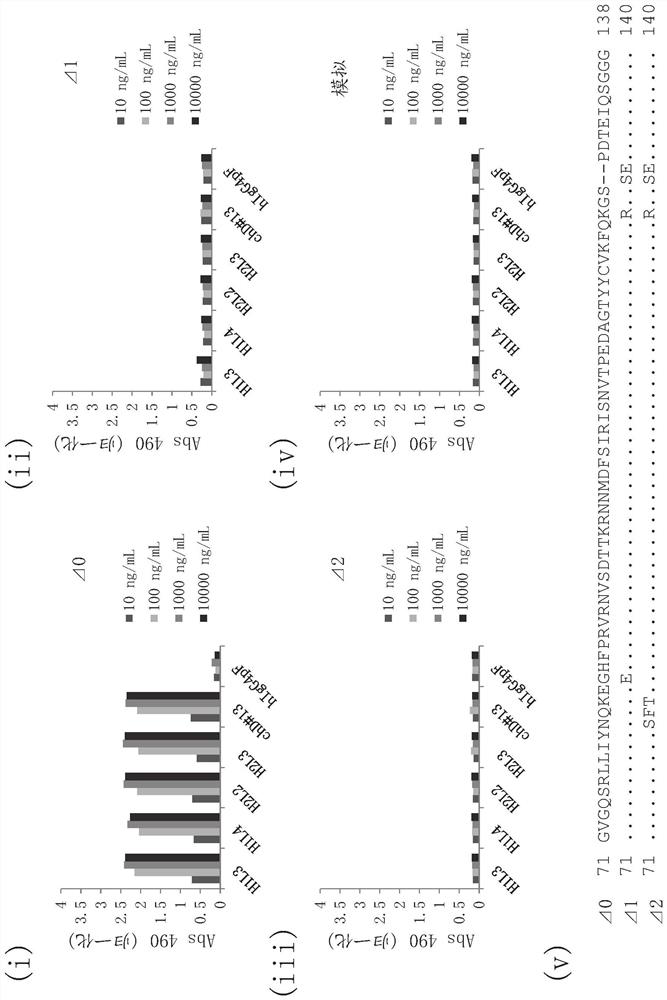ANTI-SIRPalpha ANTIBODY
An antibody, CDRL2 technology, applied in the direction of antibodies, anti-tumor drugs, anti-receptor/cell surface antigen/cell surface determinant immunoglobulin, etc., can solve the problem of no binding
- Summary
- Abstract
- Description
- Claims
- Application Information
AI Technical Summary
Problems solved by technology
Method used
Image
Examples
Embodiment 1
[0275] Example 1. Production of Rat Anti-SIRPA Antibody
[0276] 1)-1 Preparation of expression construct
[0277] 1) Construction of-1-1SIRPA_V1_ECD expression vector
[0278]By using the In-Fusion HD Cloning Kit (CLONTECH), the DNA encoding the polypeptide that is linked to HHHHHH at the C-terminal side of the 1st to 373rd amino acid sequence of human SIRPA_V1 (NCBI protein database accession number: NP_001035111) was restricted to The vector pcDNA3.3-TOPO / LaxZ (ThermoFisherSCIENTIFIC) digested with the enzyme XbaI and PmeI was combined to produce the SIRPA_V1_ECD expression vector. The amino acid sequence of SIRPA_V1_ECD is shown in SEQ ID NO:45 of the sequence listing, and the nucleotide sequence encoding SIRPA_V1_ECD is shown in SEQ ID NO:44 of the sequence listing.
[0279] 1) Construction of-1-2SIRPA_V1_IgV expression vector
[0280] A SIRPA_V1_IgV expression vector was prepared in the same manner as 1)-1-1 using DNA encoding a polypeptide having HHHHHH linked to the...
Embodiment 2
[0327] Example 2. In Vitro Evaluation of Rat Anti-Human SIRPA Antibodies (7 Kinds)
[0328] 2)-1 Construction of expression vector for antigen-binding antibody screening
[0329] 2) Construction of -1-1FLAG-human SIRPA expression vector (pFLAG V5-DEST-SIRPA_V1-V10)
[0330] The cDNAs encoding 10 human SIRPA variant proteins (excerpted from Nature Immunology 8, 1313-1323, 2007) were cloned into the pFLAG V5-DEST vector, and the vector pFLAG V5-DEST-SIRPA_V1-V10 expressing the respective variant proteins was constructed.
[0331] The amino acid sequence of human SIRPA_V3 is shown in SEQ ID NO:63 of the sequence listing, the amino acid sequence of human SIRPA_V4 is shown in SEQ ID NO:64 of the sequence listing, and the amino acid sequence of human SIRPA_V5 is shown in SEQ ID NO:65 of the sequence listing The amino acid sequence of human SIRPA_V6 is shown in SEQ ID NO:66 of the sequence listing, the amino acid sequence of human SIRPA_V7 is shown in SEQ ID NO:67 of the sequence li...
Embodiment 3
[0385] Example 3. Nucleotide sequence analysis and determination of the amino acid sequence of the cDNA of the variable region of the rat anti-SIRPA antibody (D13, F44, F63)
[0386] 3) Nucleotide sequence analysis and determination of the amino acid sequence of the variable region cDNA of -1D13
[0387] 3) Preparation of total RNA from hybridoma produced by -1-1D13
[0388] To amplify the cDNA encoding the variable region of D13, total RNA was prepared from D13-producing hybridomas using TRIzol reagent (Ambion).
[0389] 3)-1-2 Utilize 5'-RACE PCR to determine the nucleotide sequence analysis and amino acid sequence of the cDNA of the D13 light chain variable region
[0390] The cDNA encoding the light chain variable region was amplified using about 1 μg of total RNA prepared in Example 3)-1-1 and SMARTerRACE 5' / 3' kit (Clontech). As primers for amplifying the cDNA encoding the variable region of the D13 light chain gene by PCR, UPM (Universal Primer A Mix: included in the ...
PUM
 Login to View More
Login to View More Abstract
Description
Claims
Application Information
 Login to View More
Login to View More - R&D
- Intellectual Property
- Life Sciences
- Materials
- Tech Scout
- Unparalleled Data Quality
- Higher Quality Content
- 60% Fewer Hallucinations
Browse by: Latest US Patents, China's latest patents, Technical Efficacy Thesaurus, Application Domain, Technology Topic, Popular Technical Reports.
© 2025 PatSnap. All rights reserved.Legal|Privacy policy|Modern Slavery Act Transparency Statement|Sitemap|About US| Contact US: help@patsnap.com



